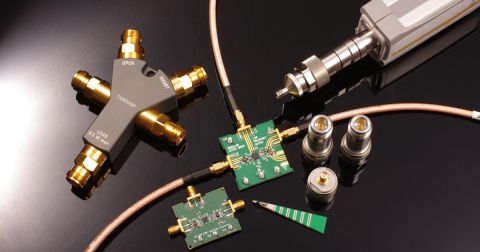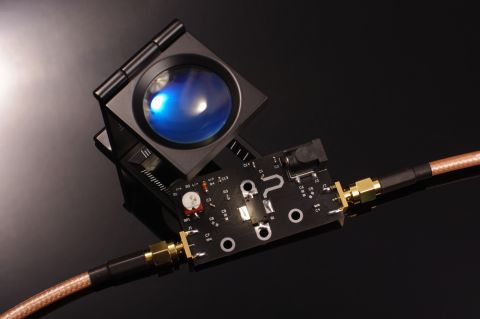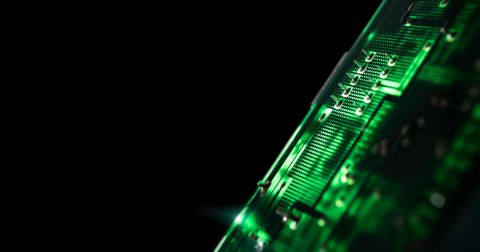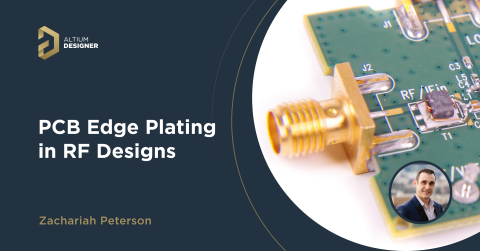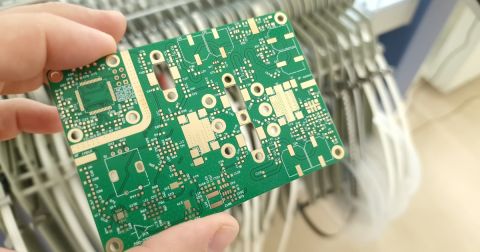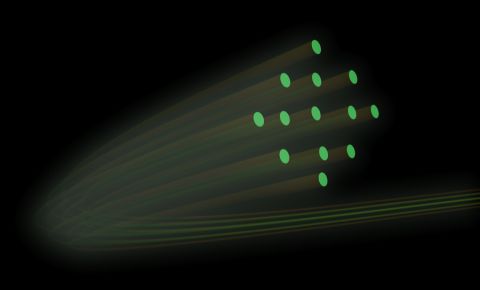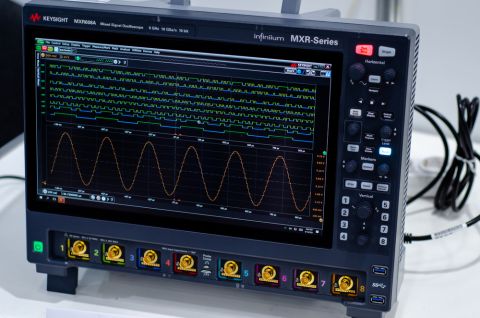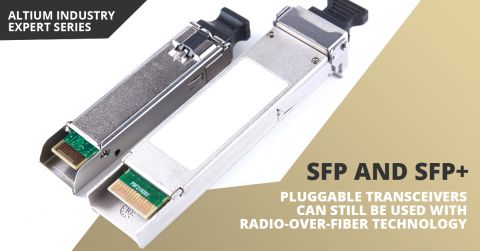Plated Through-Hole Vias in mmWave PCBs

Recently, I received a question from a designer at a startup wondering about proper use of plated through-hole vias in mmWave PCBs. This is a fair question, both when dealing with microwave/mmWave frequencies, and when working with high speed digital signals.
At mmWave frequencies, signals can experience strong reflection and resulting transient behavior as a travelling wave interacts with a via in an interconnect. If improperly sized, a signal can be strongly reflected from a via plated through-hole via, or the signal can strongly resonate. The question regarding use of plated through-hole vias at mmWave frequencies brings up another question: the use of through-hole components at mmWave frequencies. Anyone familiar with through-holes knows that they are a simple solution for routing between layers, but they can create more problems than they solve when working at high frequencies.
Modeling Plated Through-hole Vias in mmWave PCBs
When placing a plated through-hole via in an mmWave interconnect on a PCB, you're adding an element to an impedance-controlled line, and you have to consider the signal integrity consequences of that. The design challenge in dealing with this is as follows:
- Design the via to have an input impedance of 50 Ohms within the signal bandwidth (or some other system impedance value)
- Ensure insertion loss is within acceptable limits within the signal bandwidth
- If the interconnect is phase-matched to something else in the design, the propagation delay across the via needs to be known
- The frequency of the lowest-order eigenmode in the via strucutre should be higher than the signal wavelength to guarantee continuity through the via structure.
The first point is one reason you cannot trust via impedance calculators in mmWave PCBs. Any via that needs to support a signal above approximately 3 GHz cannot be designed properly with simple via impedance calculators you'll find online.
Getting Started: Understand Your Frequency and Bandwidth
In some ways, plated-through hole vias on mmWave interconnects are much easier to model and understand than digital signals with comparable bandwidths. At mmWave frequencies, your signal bandwidth is much smaller than a comparable digital signal, even though the mmWave frequency could be higher than the digital bitstream's Nyquist. As an example, consider 400G networking; running at this data rate requires using multiple signal lanes operating at 25 to 50 Gbps (16 or 8 lanes, respectively) with either NRZ or PAM-4 modulation. The bandwidth of these high speed digital signals is spread out over about half a decade, whereas a modulated mmWave signal has a much narrower bandwidth. For example, in 77 GHz FMCW automotive radar, the signal bandwidth is only 5 GHz, or only ~5% of the carrier frequency. In terms of analysis, this means you only need to consider what happens near the carrier frequency to a first order approximation.

Source: Biswas, Sudip. "Future cellular systems: fundamentals and the role of large antenna arrays." (2017).
This all means that it's a lot easier to design functional vias for mmWave signals rather than for high-speed digital signals. You only need to worry about hitting a 50 Ohm impedance target within a small bandwidth, rather than from DC up to the a bitstream's Nyquist frequency.
Distributed Parasitics
The parasitics in a via structure are not really parasitics, but they do combine to determine the total impedance of a via structure for a mmWave PCB. This causes a via's impedance to deviate significantly from 50 Ohms well above about 2-3 GHz. The distributed parasitic elements making up the via structure are shown below. There will be some additional resistance and skin effect resistance (not included in the drawing).
There is some intrinsic inductance and capacitance in the via structure, but the additional capacitances from the . The fact that a plated through-hole via has inductance should be obvious—you essentially have a loop of conductor—but the parasitic capacitance to the nearby conductors causes the via structure to be very sensitive to capacitive loading. In terms of transmission line theory, these circuit values are distributed elements, just like in a transmission line.
Can You Really Backdrill It?
There could also be a via stub on an mmWave interconnect. The via stub effectively forms an open-circuit terminated transmission line, and it will have a resonant frequency spectrum with fundamental quarter wavelength equal to the stub length, and higher order harmonics equal to odd multiples of the fundamental frequency. The leftover via stub will create some reflection that results in strong insertion loss, just like in a digital board.
Whether you should backdrill it depends on the controlled-depth drilling capability of your manufacturer. Typically, this will leave behind a stub that is 5-10 mil in length. A better option may be to use a blind via transition as this will not have any stub. Make sure to do the calculations shown in the linked blog to determine what size of stub will be acceptable in your design.
Designing the Impedance Spectrum
The impedance spectrum of a via structure for an mmWave interconnect is set by adding stitching vias around the structure, placing/removing NFPs, and setting the right antipad size. This is true for blind via-based transitions, of which there are many examples in the literature, as well as through-hole-based transitions, which are sometimes overlooked. The key here is to design four aspects:
- Via and pad size pair, which may often violate the standard guidelines for Class 2/Class 3 qualification
- The antipad through the ground planes throughout the padstack
- Elimination of NFPs to eliminate further capacitive loading
- The number and arrangement of vias in the structure
If you are having trouble setting the impedance in a simulation-driven design approach, there is something important to remember:
- The antipad size and the usage of NFPs on the signal via are the major determinant of the via's input impedance. The input impedance becomes more sensitive to the stitching via locations only when the antipad is very large
Take a look at the example below, which shows a via structure targeting the 70-80 GHz range. We can see that, at low impedance (below a few GHz), we see that the via will nominally operate very close to 50 Ohms; this actually happens to be the case in most via structures that use Class 2 or Class 3 via + pad sizing guidelines. Above those frequencies, you can quickly see that this structure is capacitive. Conventional wisdom says that this structure should be inductive, so this should illustrate how sensitive these structures can be to capacitive loading from the surrounding stitching vias and the antipad.

Example via impedance targeting the 70-80 GHz range.
Note that this structure is getting up to the edge of what most fabrication houses could reliably produce in subtractive process with mechanical drilling. To adjust the impedance of this structure, we could open or close the antipad, depending on the frequency range we want to target. Another possibility to control the impedance is to use landless vias.
For the above via transition, the via is at risk of exhibiting radiation around the structure around ~44 GHz (see the vertical green line in the plot). To help further confine the electromagnetic field in the structure, we would need to use additional sections of stitching vias. As more vias are added, we get more closure around the signal via. We might also need to place blind vias over the signal lines so that we completely close off the entry and exit regions around the via transition.
Without the stitching vias, the impedance spectrum would be flipped! It would first look inductive, but then the parasitic capacitance between the pad/via wall and the ground plane will take over and will make the via look capacitive. This should illustrate how important stitching vias are for controlling the impedance of a via structure. For example, take a look at a similar via impedance spectrum shown below; this structure has similar antipad size and no stitching vias:
Plated through-hole via input impedance spectrum without properly sized antipad and no stitching vias.
Once you get closer to the frequencies corresponding to mode excitation, we can see the impedance spectrum show strong peaks. These would correspond to strong reflections in the S11 spectrum. Similarly, when an anti-resonance arises, we would see a valley in the insertion loss spectrum. We see similar phenomena in the S-parameters for grounded coplanar waveguides due to excitation of non-TEM modes.
If You Must Use Plated Through-holes, Make Sure They’re Properly Sized
This should illustrate two important points in via design for mmWave interconnects and RF signal chains: proper sizing and suppression of resonances. The latter is rather easy; you can use a lower Dk value if you need to push resonances to a higher frequency, or you can make the structure smaller.
If through-holes must be used, the standard practice is to use grounded coplanar waveguides (GCPW) on surface layers to route signals between components for two reasons:
- The losses will be lower on the surface layers
- The size of the structure can still be made small enough to push higher-order structural resonances to high frequencies, which will ensure TEM propagation if it is needed
For propagation into a via, higher-order modes should generally be suppressed, so #2 is important unless you need a specific mode structure in the receiving component. It is important to ensure the GPCW bandwidth is as large as possible; read more about estimating the GPCW bandwidth in this article.
If you do plan to use through-hole vias in mmWave PCBs, you’ll need to use the right routing, stackup, and via design features. Altium Designer® gives you all these advanced RF PCB design tools and many more in a single program. When you’ve finished your design, and you want to release files to your manufacturer, the Altium 365™ platform makes it easy to collaborate and share your projects.
We have only scratched the surface of what’s possible with Altium Designer on Altium 365. Start your free trial of Altium Designer + Altium 365 today.

